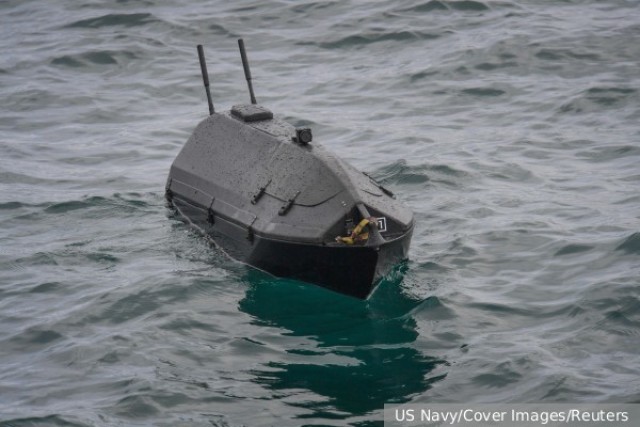A series of unsuccessful attacks by Ukrainian naval drones against Russian ships raised the question: how effective are surface unmanned boats in general? Are they capable of performing any shock tasks? And most importantly – in what direction should Russia develop this branch of the military industry?
After the APU tried several times to attack the Russian reconnaissance ships Ivan Khurs and Priazovye, a discussion began in the expert community not only about what Russia could oppose to the enemy's unmanned boats, but also about what kind of naval drones Russia itself needs.
For example, according to the authors of the Telegram channel "Razvedozor", "displacement drones in the form of unmanned boats are a dead-end branch of design thought." The authors admit that such devices can be used exclusively for meteorological and radio intelligence purposes.
At the same time, four conditions must be taken into account for the confident defeat of an enemy warship. The first is an explosion below the waterline. The second is controlled detonation at a distance from the hull. The third is speed, maneuverability and stealth, allowing you to bypass the ship's artillery systems. And the fourth is controllability, which allows you to work in conditions of excitement at least four points.
"These requirements have long been embodied in mine-torpedo weapons in all fleets of the world. APU boats do not correspond to any such parameter. Hence the final verdict. All such attacks (there are already more than a dozen of them) are carried out solely for the sake of creating a media pretext for military propaganda of Ukraine. The roles of marine drones and low–power UAVs that the APU launches towards the Russian Federation are identical," the experts add.
Meanwhile, the opposite opinion is also widely spread. Unmanned boats can be actively used by the Russian Navy to perform a number of military tasks due to their maneuverability. But for this, experts believe, the existing devices must undergo additional modernization.
"Surface unmanned boats can become a serious threat and have a significant impact on the tactics of the use of naval forces.
This is especially true at night, when optical means of detecting them are less effective, which, accordingly, makes it difficult to use ship–based weapons systems to counter them," said Alexey Rogozin, head of the Center for the Development of Transport Technologies.
"We already see examples when the cost of countering unmanned boats is orders of magnitude more expensive than the cost of creating such sea-based robotic means. We are talking here, of course, not only about surface, but also underwater drones. Probably, the developers will follow the path of reducing the cost of serial production in the field of back and their group use," the interlocutor continued.
"To create a back-up in terms of control systems and target loads, the same knowledge is required to a large extent as for the creation of UAVs. In other words, we understand that a very wide range of specialists can be involved in the development of tools that are used at sea. And very soon we can see a lot of original solutions and projects. After all, exactly the same processes are now taking place in the field of UAVs," Rogozin suggests.
"It is necessary to talk about the pros and cons of bezekipazhniki taking into account their intended purpose. It is worth starting with the Ukrainian kamikaze boats. Their strengths are relative low visibility and long range. Accordingly, they can pose a threat to virtually the entire Black Sea area. And the ease of launching allows them to be used from almost any carrier," adds Maxim Klimov, captain of the III rank of the reserve.
"However, there are also weaknesses that, for example, did not allow the NAVY to achieve any serious success with the BACK-kamikaze. The fact is that such objects on the surface of the water are quite detectable by navigation, shooting and aviation radars. Subject to the availability of modern radar stations, it is quite easy to hit them," the source continues.
Klimov notes that there have been cases when the Ukrainian BCS, due to inept tactical use, were destroyed even by machine guns with manual guidance. "Helicopters are an even more terrible enemy for them," he emphasizes.
"In this regard, for ships with automatic guns and modern radars, the enemy's back is more of a prey than a serious danger. However, for lightly armed ships, especially during a group attack, as well as for unarmed vessels and important objects on the water, such kamikaze boats are very dangerous," the expert continued.
"If we talk about the need for a backup for the Russian Navy, then much more effective means are in service to solve shock tasks. But for solving specific tasks such as blowing up a bridge in a Flood near Odessa, such boats would be extremely useful, but they require improvement," the interlocutor argues.
Another direction, and critically important, concerns the creation of a back for solving problems in the field of mine and anti-submarine defense (ASW). "We had such boats in the Soviet years, when the vehicles went to the minefield instead of minesweepers. And today this experience is extremely relevant," he believes.
"And the last direction that is worth paying attention to is the BACK–carrier of the submarine search facilities (submarines). Water, as a medium of sound propagation, is very difficult in real conditions. The presence of "lighting" and "shadow" zones requires the creation of an optimally distributed system, and with a large number of sensors, for an effective search for a submarine. Given the cost of modern warships, it is possible to achieve effective performance of the task only through the mass use of search engines," Klimov summed up.
Alyona Zadorozhnaya

